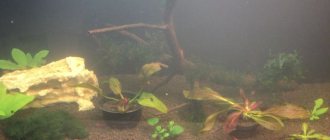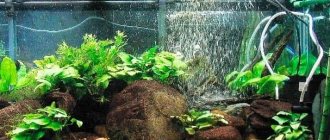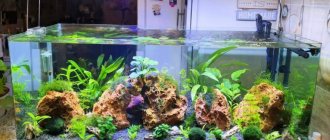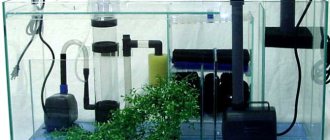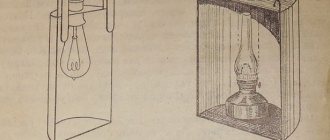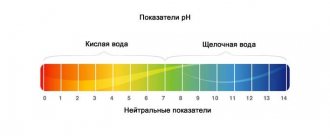Home/AQUARIUM CARE/How to cool water in an aquarium: basic cooling methods
How to cool water in an aquarium? This is a question that beginner aquarists ask themselves in the summer. After all, it is during this period that the probability of death of fauna representatives increases significantly. If you don't take action, you could lose all your pets.
Inexperienced aquarists in hot weather increase the frequency of changing aquarium fluid, using cold water for these purposes. Sharp temperature fluctuations provoke the death of fauna and beneficial bacteria. What to do?
Installation of monitoring station
To monitor all parameters in the tank, experienced aquarists use monitoring stations. With the help of such units the following is monitored:
- Temperature level.
- Acidity and hardness of the liquid.
- Precipitation amount.
- Other.
But the cost of such units is quite high. And the parameters of aquarium water do not always need to be monitored. The purchase of such equipment is carried out by aquarists who care for capricious or exotic fish. After all, with their help you can adjust the temperature.
Aquarium water heaters
A heater is a device that lasts a long time. Our advice is not to skimp and choose a heating pad carefully. Today there are two types of heaters - immersion and flow-through. There are different modifications of them, for example, bottom, fixed - with a preset temperature. There are also differences in size.
Let's look at each option in more detail. And let’s do this using ISTA heating pads (Taiwan) as an example; they are widely represented on the market and combine the best in price and quality.
Ambient temperature control
This method is easy to implement. After all, the water in the tank is heated to the same level as the air in the room in which the tank is located. To prevent overheating of the liquid, you should cover the window openings with curtains.
Air conditioning systems or fans are used to ventilate the room. With the help of such units, optimal performance is maintained.
Submersible heaters for aquariums
This is the most common type of aquarium heater. There are: glass, ceramic, plastic.
For example, check out the ISTA Mini Fixed Temperature Heater - mini, micro heating pads!
A very cool thing for naniki and aquariums with bettas! And there is no need to tell on the forums that there are no mini-hot water bottles, that the cockerels are kept at a temperature level: “Like they inhaled in the house.” You can't do that. If you bought a cockerel, please, create comfortable conditions for him!
Ista actually has a whole series of Ista Fixed Temperature Heater - for any size and power. Your task is only to choose.
In the assortment you will find:
— Compact ISTA heater with preset temperatures of 25, 28 and 33°C, height 50mm, 10W.
— Compact ISTA heater with preset temperatures of 25, 28 and 33°C, height 65mm, 15W.
— Compact ISTA heater with preset temperatures of 25, 28 and 33°C, height 110mm, 30W.
— Compact ISTA heater with preset temperatures of 25, 28 and 33°C, height 140mm, 60W.
— Compact ISTA heater with preset temperatures of 25, 28 and 33°C, height 240mm, 120W.
— Compact ISTA heater with preset temperatures of 25, 28 and 33°C, height 295mm, 300W.
— Compact ISTA heater with preset temperatures of 25, 28 and 33°C, height 340mm, 500W.
— Compact ISTA heater with preset temperatures of 25, 28 and 33°C, height 400mm, 800W.
These thermostats can maintain 3 temperature levels in aquariums: a temperature of 25C - which is excellent for most aquatic plants and for marine aquariums; a temperature of 28 C is suitable for most types of tropical fish, and a temperature of 33 C is required for keeping warm-water fish species (for example, discus) or during the treatment of certain diseases.
In general, it is worth saying that the modern aquarium market provides us with a huge range of heaters. There are heaters in which you can independently set any temperature regime. If you want this option, take proven and high-quality brands, for example, Tetra heating pad - Tetra HT 25, 50, 75, 100, 150, 200, 300 .
Tetra HT
Time-tested, recommended by FF! 5 years of use and no complaints!
Why do we focus on quality?! Because many glass heating pads, especially cheap ones made in China, are crap, the thermostat in them does not work correctly - you set it to 25 degrees, but it heats up to 28 degrees. We actually once had a case when the XiaoLiaoHeater actually cooked the fish - it fried it at 35 degrees and did not turn off. Returning home, we had to urgently save the fish... Actually, after this incident, we never scrounged for a good heating pad again =)
Just don’t think that we are against the “Chinese”. Let me tell you, now many famous brands are also “China”. We simply do not recommend that you take a frankly cheap heating pad, which does not inspire confidence even at first glance.
If your budget is limited, take the ATMAN heating pad - good heaters from the Middle Kingdom that have been proven for decades.
Atman heaters
Atman Heater series heaters - for freshwater and marine aquariums from 10 to 50 liters. Made from very durable glass. Setting range from 18 to 34 degrees Celsius, measurement error ±1° C.
Atman heaters of the Galaxy series - for freshwater and marine aquariums from 50 to 300 liters. Made from very durable glass. Setting range from 20 to 34 degrees Celsius, measurement error ±1° C.
Atman heaters of the FIXED series - for freshwater and marine aquariums from 5 to 50 liters. Made of heat-resistant quartz glass. The devices are set to maintain a temperature of 26 degrees Celsius, measurement error ±1° C.
So, well, at the end of the conversation about heaters, let’s say that there are heaters in a plastic shockproof braid.
If you have, say, turtles or aggressive, large fish, for example, cichlids, which can easily move stones, you need a safe heating pad in plastic.
Let's summarize. Aquarium heaters are devices that should serve faithfully for a long time. Don't skimp and carefully choose a device to suit your needs.
Changing filter characteristics
Heating affects the volume of air present in the liquid. Its numbers decrease on especially hot days.
Internal filtration units are located near the surface so that the liquid in the tank is cooled. If the aquarist has an external filter, then it should be equipped with a flute tube. With its help, water reaches the surface, improving aeration rates.
This makes it easier to cool small containers containing representatives of flora and fauna. In this case, it is necessary to control temperature indicators using appropriate devices.
What is a chiller?
First, it’s worth understanding what a chiller is in general. A chiller is a special device for cooling wort. The fact is that the brewed wort must be cooled as quickly as possible, otherwise we risk the entire batch. At high temperatures, bacteria multiply faster, which means the longer the wort remains hot, the greater the chance of infecting it with unwanted pathogens. Slow cooling also has a detrimental effect on the taste of homemade beer. The third factor that votes FOR a chiller is the volume of brewed beer. If the volumes are not large (5-10 liters), then cooling will take place quickly enough; just take a larger pan. But if you brewed 50 liters, you can’t do without a chiller.
Cooler
You can cool the water in an aquarium yourself using a cooler from an old computer. To use this aquarium cooler, you need to follow a few simple steps:
- The aquarium fan is located on the lid in the place where you plan to install it. Chalk is used for marking.
- According to the applied markings, a corresponding hole is cut. A pre-prepared cooler is placed in it. The space between the cooler and the rim of the lid is coated with a pre-selected sealant. It will take some time for the composition to completely harden.
- The plug is separated from the pre-prepared charge. After this, the wires are separated and stripped. When connecting the wires, it is important to ensure that the shades match. Only in this case will the chiller rotate in the required direction. If necessary, they can be changed.
To increase the efficiency of the formed structure, 1–2 coolers should be installed. Such homemade installations are placed at an angle. This aquarium cooler should be used around the clock in the summer to prevent overheating.
Danger and signs of water overheating
Fish are aquatic creatures that are not able to independently change their body temperature. Because of this, many species can only exist in water that has a certain temperature, and excessively cold or warm water is dangerous for them. In hot weather, when the risk of overheating of the inhabitants of the aquarium increases significantly, the aquarist should carefully monitor their behavior. Certain changes in it help to understand, even without using a thermometer, that the water is too hot.
The main indicators of an excessive increase in its temperature are:
- lethargy of fish - they hardly move and often just lie on the bottom, even if they are not bottom-dwelling species;
- movement of fish into the upper layer of water - this indicates that overheating has become significant;
- fish regularly swallow air from the surface of the water - the exception is labyrinthine species that breathe atmospheric air, and for which swallowing water from the surface is the norm.
If aquarium fish behave this way, it is necessary to immediately take measures to cool the water, since further overheating poses a serious danger for them. Delicate fish species that require strict maintenance of optimal living conditions react especially quickly and severely to rising temperatures in their ponds.
Important! In hot summer weather, it is advisable to check the aquarium thermometer 3-4 times a day so as not to miss an increase in temperature and use the cooler in time.
The danger of overheating water in an aquarium is associated with several factors that negatively affect its inhabitants. Their temperature rises when the water is too warm, which disrupts metabolic processes in the body, which negatively affects their health. If these changes are too severe, they will lead to death, even if the water temperature is already lowered. That is why it is impossible to postpone procedures for cooling it for a long time.
When water is overheated, the amount of oxygen in it decreases, causing fish and other aquarium inhabitants to begin to suffocate. The situation is further worsened by the fact that at high temperatures, harmful bacteria and algae multiply much faster, as the amount of waste from the inhabitants of the aquarium increases. In addition, excrement decomposes much faster in superheated water, and it is intensively saturated with substances released during this process. They are toxic to the inhabitants of the home pond, which leads to severe poisoning and death. Because of this, cooling the aquarium must be carried out urgently and competently.
Decrease in temperature level
Filter upgrade
For an aquarium, you create a cooling system using a filter with your own hands. This option is suitable if the tank is equipped with an internal filter. A washcloth is removed from this system, with the help of which the liquid is cleaned. Ice is placed in place of the washcloth.
With this homemade product, the aquarium liquid cools in 5–10 minutes. But before using such a system, experts recommend purchasing a temperature tracking device. After all, excessively cold water will provoke the death of fish and shellfish phenotypes.
Container with ice
Fill 1-2 bottles with ice. They are placed in a container with fish and shellfish. This method is similar to the one described earlier. But at the same time, the liquid in the aquarium cools gradually. The temperature level is constantly monitored to prevent hypothermia. For these purposes, a controller or other component is suitable, with the help of which it is easy to regulate the temperature level in the tank.
Cooling system with Peltier elements
Experienced aquarists prepare cooling systems for their aquariums with their own hands, which include a Peltier element. To construct such a system, the following components are used:
- Coolers from old computers. Such parts contribute to noise. Among modern installations it is easy to find parts with which ventilation is performed almost silently.
- Peltier element. The system is constructed on 2 elements. Their power is determined individually. In this case, the dimensions of the tank, its equipment, and phenotypes are taken into account.
- Radiators. They are used to remove generated heat.
- Cooling water block. Each Peltier element is placed in it.
- Thermal controller. The temperature level is regulated using a thermal controller.
- A power supply whose output voltage is 12 Volts.
- Water pump. Experienced aquarists install pumps in advance. If such a device is not available, it must be purchased separately. The performance of such a device is determined individually. Such points as the size of the aquarium and climatic features are taken into account.
The system, which includes a Peltier element, is used by beginners and experienced aquarists to cool liquids. For what reason is it popular?
- With the help of such a refrigeration system, the temperature is reduced to the required level. Suitable components and devices are used for continuous monitoring.
- Autonomy. Before using such a system, you should monitor its performance for 2-3 hours.
- Low energy consumption.
- Efficient coolers.
- Optimal dimensions.
Before choosing a method by which the liquid in the aquarium will be cooled, you should study the features of each. For small containers, a filter filled with ice or a cooler is suitable. For larger tanks, cooling systems that are equipped with adjustment elements will be required.
Video about different ways to cool small and large aquariums
AdminAuthor of the article
Did you like the article?
Share with your friends:
Chiller for aquarium TsentrProm-Holod
- cooling water volume from 150 to 4000 liters
- low noise performance
- electronic temperature control and control processor
- compressor thermal protection
- compressor voltage protection
- minimum final temperature of water cooling to +5 C0
- production time up to 10 working days
Since we are manufacturers, at your request, it is possible to calculate the cooler (chiller) for any other conditions and any configuration. It is also possible to take into account the desired dimensions and type of execution.
To place an order, please use this form
Description of industrial chiller
Chiller (water-cooling machine) is a device for cooling liquid through a vapor-compression or absorption refrigeration cycle. After the temperature has decreased, the liquid is used to cool the air in the heat exchanger (fan coil) or to remove heat from equipment.
Operating principle of an industrial chiller
The device is used in various industries. A cooling unit in a connected system with a fan coil is used in some models of air conditioners.
Operating principle of an industrial refrigeration plant
In production, special absorption chillers are used as a rapid heat removal unit. It is necessary to ensure the operation of various industrial equipment that generates heat. The chiller selects and removes excess heat and maintains the optimal temperature and thermal conditions of the equipment. Lithium bromide in water is used in industrial installations as a liquid that absorbs gas in full.
During the cooling process of water, excess heat is released, which is released into the environment.
The industrial installation consists of two blocks:
- top - generating hot container with relatively high pressure;
- lower - includes an evaporation tank and a section with an absorbent.
Nature of operation of the installation:
- The heat from the generator affects the absorbent, which releases water vapor.
- The steam is transferred to the condenser and turns into a liquid state, giving off heat to a special reservoir of water.
- Having lost heat, water from the condenser is supplied to the evaporator.
- Here the water evaporates under pressure, absorbing heat from the refrigerated circuit (chiller).
- By pumping boiling water through a pumping unit, heat transfer is enhanced.
- At this time, the remaining absorbent concentrate is transferred to the absorber, where gas is absorbed from the evaporator and heat is released.
- The exhaust circuit removes heat from the absorbent container outside the installation.
- After the heat is removed, the resulting water and absorbent are again transferred to the generator.
Advantages of chillers over compression refrigerators:
- small amount of energy consumed;
- low noise emission during operation;
- environmental friendliness, because the working substance is plain water, not freon;
- absorb the released energy;
- long period of effective operation;
- industrial safety;
- ease of control.
Flaws:
- price;
- the need for a source of hot energy;
- heavy weight;
- high water consumption of the system.
Chiller for beer production
Water cooling machines are actively used in beer production. It is used to cool the wort. When receiving malt liquor, you need to quickly reduce the temperature. The quality of the drink depends on this. This broth contains beneficial and harmful bacteria. Beneficial elements are preserved at temperatures above 60°C, and all harmful bacteria die. But with slow cooling after 60°C, the likelihood of the appearance of harmful microorganisms increases. Therefore, it is necessary to reduce the temperature quickly.
The importance of the speed of the production process is also reflected in the fact that the fermentation process and the addition of yeast can only be carried out at a favorable temperature of about 20°C.
When the broth cools slowly, a large number of bacteria are formed. Yeast, when added, will not be able to absorb excess microorganisms. The drink will be spoiled. Slow cooling also impairs the commercial quality of the product.
Chiller device for a small brewery
In fact, a chiller operating on the principle of a moonshine still exists. Hot wort is driven through the coil, and the external chiller itself is immersed in cold: running water or a container with the same ice.
The efficiency of such a device is higher than a saucepan immersed in a tub of ice. And yet, when hot beer moves through pipes, instantaneous cooling does not occur.
The next stage of technology is a plate chiller. It is a classic honeycomb radiator in which wort moves through tubes. In the outer container, cold water moves towards the wort. Thanks to counterflow, the chiller cools the beer almost immediately. The only drawback is that while the hot wort is moving through the pipes to the chiller, the negative processes have time to do their “dark and muddy” work.
The most efficient is the immersion cooler. This is a spiral-shaped chiller with refrigerant in the tube. When the heat exchanger (more precisely, the cooler) is turned on, the wort is cooled instantly.
The formation of bacteria does not occur; the rags of bruja immediately bind and settle to the bottom. And dimethyl sulfide, in principle, cannot be formed at such a rate of temperature drop.
The diameter of the tube is selected depending on the volume of cooled liquid. There is a principle of reasonable sufficiency: a chiller spiral that is too thick will require a powerful refrigeration unit.
The material used for production is neutral: usually copper. You can try food-grade aluminum, but it is too fragile for such temperature changes. They also use stainless steel tubes, although they are more expensive than copper ones and are much more difficult to bend.
3 secrets for making a do-it-yourself submersible chiller
The first secret is the diameter of the tube; the larger the diameter, the larger the heat transfer area!
The second secret is the number of turns - the principle is the same
The third secret is the coil diameter.
It is worth noting that all 3 of these parameters significantly affect the price. So, if you want to make a cheaper chiller, then know that the price is not only in rubles, but also in efficiency.
How to use a homemade beer chiller
We immerse the chiller in the center of the pan, connect it to the tap, lower the other end into the sink, and open cold water! All! You can stir the wort to cool evenly.
Sources
- https://homebeer.csutio.ru/oborudovanie-dlya-varki-piva-doma/kak-sdelat-chiller-dlya-piva-svoimi-rukami/
- https://vozduhstroy.ru/kondicionery/chiller-svoimi-rukami.html
- https://cp-h.ru/tehnicheskaya-informatsiya-po-holodiljnoy-tehnike/chiller-svoimi-rukami.html
- https://teplobloknn.ru/oborudovanie/samodelnyj-chiller.html
- https://saiding-v-permi.ru/oborudovanie/chiller-protivotochnyj-svoimi-rukami.html
- https://varimtutru.com/chiller-iz-nerzhaveyki-svoimi-rukami/
- https://paes250.ru/delaj-sam/kak-sdelat-chiller-svoimi-rukami.html
[collapse]



